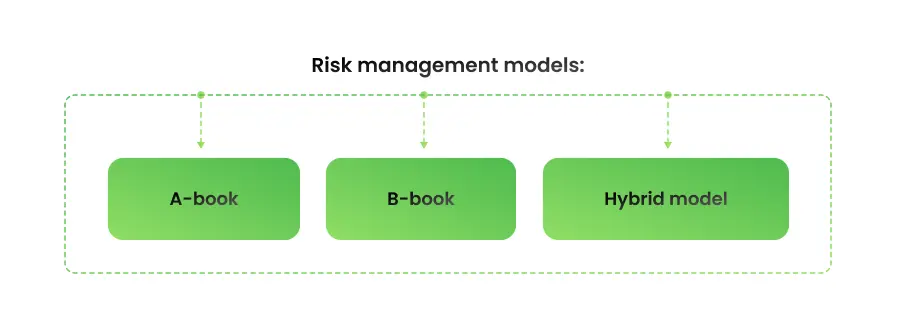Load balancing between multiple liquidity providers using TickTrader Liquidity Aggregator
- An issue in question
- Popular risk management models: a broker’s outlook
- Maintaining the balance in Admin Eye
- What is a good risk management routine
Balancing the load between liquidity providers is one of the main tasks of any broker's risk management department. Excessive exposure of liquidity providers to toxic flow can lead to conflicts that are much easier to prevent at the root than to solve post-facto. We will break down the tools in our TickTrader Liquidity provider product that will make it easy to balance funds when a broker operates through multiple liquidity providers.
An issue in question
It is very important to choose the right liquidity provider for your Forex brokerage. Having multiple liquidity providers can be beneficial for Forex brokers, especially those looking to provide their clients with the best possible experience. By having multiple liquidity providers, a broker can provide access to a wider variety of market conditions, access to greater liquidity, faster executions, and a smaller amount of risk for their customers.
However, brokerage firms can face several problems when it comes to managing multiple liquidity providers. For example, a broker may have to set up and maintain multiple systems, such as a liquidity aggregator with a bridge component that connects brokerage with liquidity providers.
However, if the broker’s system is not properly set up, it can lead to a number of problems, such as execution delays, lost connections, and even missed opportunities. To mitigate these issues, many brokerage firms have begun to use “smart” liquidity aggregators. These aggregators are designed to provide brokers with the ability to automatically switch between multiple liquidity providers, without any interruption to the trading process, and refine the quote flow using instruments like automated filters. This can provide a number of benefits, such as faster execution, increased liquidity, and more efficient risk management.
However, there are also a number of potential drawbacks to using multiple liquidity providers. For example, a broker may find that the associated costs are too high, or that the reduced liquidity from individual providers can reduce the ability to take advantage of market opportunities. Additionally, when selecting liquidity providers, brokers will need to ensure that they are in compliance with regulations.
Popular risk management models: a broker’s outlook
Let's start by taking a closer look at the A-book, B-book, and hybrid Forex broker business models, and highlighting their main features and differences from the broker's perspective, and how they all can affect the liquidity and risk management processes.
A-book
First of all, let’s talk about what is an A-book broker in Forex. The definition of the A-book model is a brokerage operation scheme that transmits all client trades directly to the interbank market. Thus, the broker acts only as an intermediary, while the market acts as a counterparty. The broker's income consists of markups and commission.
B-book
Now, let’s talk about what a B-book broker is. The B-book or market maker (MM) is a model of risk management in brokerage firms, where the broker serves as a liquidity provider for a client transaction that does not reach the interbank. Unlike A-Book, the FX B-book model does not imply overlapping trades via liquidity providers. Thus, a B-book broker bears the responsibility to the client with their own funds, i.e. the client's profit is the broker's loss and vice versa.
Hybrid model
With this alternative model, Hybrid Forex brokers have the ability to decide where to send profitable trades, to liquidity providers or to internal execution. The flow of profitable trades, which is usually sent to liquidity providers, is commonly referred to as toxic.
When a liquidity provider notices a blatantly toxic flow, they can degrade execution quality for that broker. This can affect traders in the form of frequent slippages. To avoid this, it’s imperative to analyze the flow of trades and develop certain mechanisms for handling profitable clients. We will discuss this below.
Also, the right technical tools can help a risk manager to maintain the right balance between internal and external liquidity. For example, Forex Broker Turnkey from Soft-FX is an off-the-shelf solution that includes the trading multiplier system, where each trading account on the platform can be assigned a trading multiplier. The value of this multiplier determines the percentage of the requested trading volume that goes to the external market. This feature helps mitigate the possibility of exposing liquidity providers to toxic flows, while effectively hedging risks.

Maintaining the balance in Admin Eye
When a risk manager has correctly singled out and hedged the profitable clients, another challenge is to make sure that Forex brokerage liquidity providers do not cut off flows of these traders as toxic. Simple math shows that the more liquidity providers you have, the easier it will be to distribute flows from profitable clients and obtain a healthy-looking liquidity pool. For example, in case a provider is unhappy with a certain flow, the risk manager can simply worsen that provider's prices for the trader who generates that flow.
Also, the employee responsible for robust broker risk management in the brokerage business should stand ready to negotiate with liquidity providers and defend price values at the time of execution in a disputed situation.
In the Admin Eye administrator environment there is an Position Report External section. It contains three panels with key information on open positions. The first panel presents information on two vital categories:
- In the first category are all positions open on the banks. The administrator is spared the need to access each account separately, unless they want to check the relevance of the information presented, as the category displays the NET position for all providers. When adding a new liquidity provider, the administrator has the ability to set unique parameters, such as the value of leverage. If the margin level is overloaded, a special indicator alerts about it. The administrator can also set the sequence of provider replacements if there is a possibility of the main one being disconnected.
- The second category represents positions open with clients for all the trading symbols. For each client account, the administrator can set a special coefficient, which determines how much of the open volume of positions will be sent to external providers for execution.
Thus, in the hands of the administrator and risk manager is a tool for ideal balancing of internal and external liquidity, as well as preventing conflict-free relations with Forex brokerage liquidity providers.
What is a good risk management routine
At the end of the day, the best approach to working with multiple liquidity providers for a Forex brokerage is to use a “smart” liquidity pool aggregator that serves as a bridge between a brokerage and a liquidity source. This can provide a number of advantages, including improved liquidity, faster execution speeds, and improved risk management. However, it should also be noted that there are potential drawbacks to using multiple liquidity providers, such as higher costs, reduced liquidity, and regulatory issues. The key is to carefully evaluate the pros and cons of using multiple liquidity providers before deciding if this approach is right for a particular brokerage firm.
The Forex Broker Turnkey solution includes all the key components required for effective risk management in Forex brokerage firms, including a smart liquidity aggregator.
Our team is ready to provide a detailed advice list on the basics of Forex broker risk management with the help of Soft-FX technologies.



